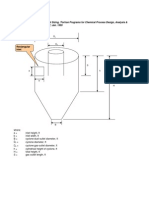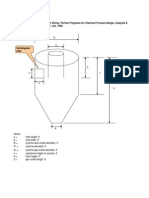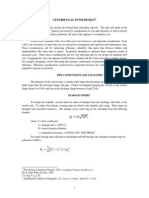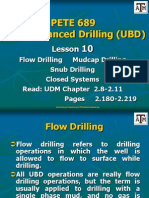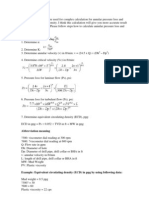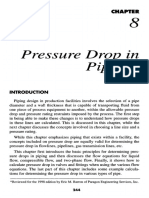Cyclone Separator Press Drop
Cyclone Separator Press Drop
Uploaded by
Cristian MartínezCopyright:
Available Formats
Cyclone Separator Press Drop
Cyclone Separator Press Drop
Uploaded by
Cristian MartínezCopyright
Available Formats
Share this document
Did you find this document useful?
Is this content inappropriate?
Copyright:
Available Formats
Cyclone Separator Press Drop
Cyclone Separator Press Drop
Uploaded by
Cristian MartínezCopyright:
Available Formats
Pressure Drop in Cyclones
Reference: Chapter 4, Equipment Sizing, 'Fortran Programs for Chemical Process Design, Analysis & Simulation' by 'A. Kayode Coker'; Jan. 1995
Dc
De
Rectangular Inlet
S a h
b H
where: a= b= B= Dc = De = h= H= S=
inlet height, ft inlet width, ft cyclone dust-outlet diameter, ft cyclone diameter, ft cyclone gas-outlet diameter, ft cylindrical height of cyclone, ft total height, ft gas outlet length, ft
Equation for Pressure Drop
DP 0.003 r f vi N H
2
where: DP = rf = vi = NH =
pressure drop, inches H2O inlet gas density, lb/ft3 inlet velocity, ft/s number of inlet velocity heads, dimensionless
ab NH K 2 D e
K= K= Inputs a= b= De = rf = Q= K= Calculations vi = NH = DP =
(Note 1)
16 for no inlet vane 7.5 with a neutral inlet vane
4.5 ft 1.896 ft 3.792 ft 3 0.075 lb/ft
3 516.7 ft /s 16
(total gas flow rate)
60.6 ft/s 9.5 7.834 in. H2O 0.020 bar
(Q/ab) (Note1)
Notes 1. For circular inlet to the cyclone use cross-sectional area as 'pd2/4' instead of 'ab' for rectangular inlet, where 'd' is inside diameter of inlet nozzle. 2. Correlations for the pressure drop have been empirical and are acceptable up to DP = 10 in. H20. The pressure drop (DP) or the frictional loss is expressed in terms of the velocity head based on the cyclone inlet area. The frictional loss through cyclones is from 1 to 20 inlet velocity heads and depends on the geometric ratios. Prepared by: Ankur Srivastava Chemical Engineer Email: ankur_2061@hotmail.com
You might also like
- Sieve Tray CalculationsDocument4 pagesSieve Tray CalculationsWade Coleman75% (4)
- Smacna Duct Designfundamentals PDFDocument151 pagesSmacna Duct Designfundamentals PDFandi nainggolan100% (2)
- Flow-Induced Vibrations: An Engineering GuideFrom EverandFlow-Induced Vibrations: An Engineering GuideRating: 5 out of 5 stars5/5 (2)
- Calculation and Design of Packed Column For AcidDocument14 pagesCalculation and Design of Packed Column For AcidDavid Lambert100% (1)
- Cyclone Separator Press DropDocument2 pagesCyclone Separator Press DropAtul JainNo ratings yet
- Cyclone Separator Press DropDocument2 pagesCyclone Separator Press DropImtinan MohsinNo ratings yet
- Cyclone Separator Press DropDocument2 pagesCyclone Separator Press Dropjnmanivannan100% (4)
- Formula SheetDocument4 pagesFormula SheetAlbertoBila100% (1)
- Lab Manual 2012 Fluid MechanicsDocument23 pagesLab Manual 2012 Fluid MechanicsUsman HaiderNo ratings yet
- Cavitation PaperDocument11 pagesCavitation PaperMohammed khudhairNo ratings yet
- Discharge CoefficientDocument11 pagesDischarge Coefficientsisai12u2420% (2)
- Centrifugal Pump Design - Rev 2Document11 pagesCentrifugal Pump Design - Rev 2jehadyam100% (1)
- Calculation of Orifice CoefficientDocument18 pagesCalculation of Orifice Coefficientvinayjoshi270586No ratings yet
- Orifice, Nozzle and Venturi Flow Rate MetersDocument10 pagesOrifice, Nozzle and Venturi Flow Rate Metersphiena1fcNo ratings yet
- Scilab Programs in Chemical Engineering For BeginnersDocument24 pagesScilab Programs in Chemical Engineering For BeginnersvivekNo ratings yet
- Partially Full Pipe Flow CalculationsDocument17 pagesPartially Full Pipe Flow Calculationsjaffna0% (1)
- List of Experiments of Fluid LabDocument24 pagesList of Experiments of Fluid LabGhufran Ahmed0% (1)
- Centrifugal Pump DesignDocument15 pagesCentrifugal Pump Designzakibrant23No ratings yet
- Gravity Fluid Flow Design GuideDocument15 pagesGravity Fluid Flow Design Guidec_nghiaNo ratings yet
- Validation Report On The 2-Phase Line SizingDocument18 pagesValidation Report On The 2-Phase Line SizingEbby Onyekwe100% (1)
- Pipeline Hydraulic Analysis Lec 6Document30 pagesPipeline Hydraulic Analysis Lec 6Kokab AzazNo ratings yet
- 46716D Calculation of Orifice Coefficient Us UnitsDocument18 pages46716D Calculation of Orifice Coefficient Us UnitsDougMooreNo ratings yet
- ML050660028 Airwater flowinHydraulicStructuresDocument68 pagesML050660028 Airwater flowinHydraulicStructuresAlfonso Carvajal RodríguezNo ratings yet
- A Presentation On Rig Maths: by Rituraj Sarmah Dy. Chief Engineer-DrillingDocument10 pagesA Presentation On Rig Maths: by Rituraj Sarmah Dy. Chief Engineer-DrillingsubhashNo ratings yet
- Publication 3 6821 6015Document3 pagesPublication 3 6821 6015Kamal JoshiNo ratings yet
- RMS Inlet Pressure Calculation TheoryDocument22 pagesRMS Inlet Pressure Calculation TheoryRajesh SarkarNo ratings yet
- Characteristics of OrificeDocument6 pagesCharacteristics of OrificePohSing VestNo ratings yet
- Venturimeter ExptDocument9 pagesVenturimeter Exptatif irshadNo ratings yet
- Hydraulic Design of Trench WeirDocument8 pagesHydraulic Design of Trench WeirBharat SharmaNo ratings yet
- 6 - Lec6-Pipeline Hydraulic AnalysisDocument30 pages6 - Lec6-Pipeline Hydraulic Analysisengrkashif835No ratings yet
- PED Ch1Document17 pagesPED Ch1dpatel 2310100% (1)
- 7651bc0b3f PDFDocument69 pages7651bc0b3f PDFameer100% (1)
- Pressure Relief Valve Engineering Handbook - CrosbyDocument9 pagesPressure Relief Valve Engineering Handbook - CrosbyDiego EscalanteNo ratings yet
- Centrifugal Pump DesignDocument11 pagesCentrifugal Pump DesignPeter PerezNo ratings yet
- 7b Orifice Plate and VenturimeterDocument6 pages7b Orifice Plate and VenturimeterJAIRAM JaiNo ratings yet
- Lesson 10 Flow Mudcap Snub Closed Systems1Document50 pagesLesson 10 Flow Mudcap Snub Closed Systems1Heris SitompulNo ratings yet
- m c θ c θ c c: n vi liDocument4 pagesm c θ c θ c c: n vi liVanessa SimNo ratings yet
- Orifice, Nozzle and Venturi Flow Rate Meters: Water & Air FlowmetersDocument4 pagesOrifice, Nozzle and Venturi Flow Rate Meters: Water & Air Flowmeterssiva_nagesh_2No ratings yet
- Distillation Tower Design: Tower Diameter, Height, Pressure Drop (Seader Seider Lewin Chapter 14.6, 14.7)Document13 pagesDistillation Tower Design: Tower Diameter, Height, Pressure Drop (Seader Seider Lewin Chapter 14.6, 14.7)Matone MafologelaNo ratings yet
- Equivalent Circulating Density 2Document3 pagesEquivalent Circulating Density 2Miguel VelazcoNo ratings yet
- Lecture 2. Sewer HydraulicsDocument13 pagesLecture 2. Sewer HydraulicsshamashergyNo ratings yet
- Fluid Dynamics Student ManualDocument70 pagesFluid Dynamics Student ManualJayachandran SivagurunathanNo ratings yet
- Fluid Flow Lecture Notes - 9Document13 pagesFluid Flow Lecture Notes - 9Lin Xian Xing100% (1)
- AGA-3 Orifice - DocDocument4 pagesAGA-3 Orifice - Docsuci wulandariNo ratings yet
- Pipeline Systems: Monroe L. Weber-Shirk S Civil Environmental EngineeringDocument29 pagesPipeline Systems: Monroe L. Weber-Shirk S Civil Environmental EngineeringLai YenNo ratings yet
- Pressure Drop CalculationDocument30 pagesPressure Drop CalculationEbby Onyekwe100% (3)
- Pressure Drop in PipingDocument41 pagesPressure Drop in PipingFrancisco Rivas50% (2)
- 8.pressure Drop in Piping PDFDocument41 pages8.pressure Drop in Piping PDFStalin Apolo100% (1)
- Module 4a - Line Sizing CalculationDocument9 pagesModule 4a - Line Sizing CalculationEkundayo JohnNo ratings yet
- Elbow TapsDocument4 pagesElbow TapsSupraja SundaresanNo ratings yet
- Pressure Drop CalculationDocument7 pagesPressure Drop CalculationShahnawaz hashmiNo ratings yet
- PRO2000Document72 pagesPRO2000scrbdgharaviNo ratings yet
- Edr 2 ElarmoDocument15 pagesEdr 2 ElarmoArfel Marie FuentesNo ratings yet
- Southern Marine Engineering Desk Reference: Second Edition Volume IFrom EverandSouthern Marine Engineering Desk Reference: Second Edition Volume INo ratings yet
- Case Studies in Fluid Mechanics with Sensitivities to Governing VariablesFrom EverandCase Studies in Fluid Mechanics with Sensitivities to Governing VariablesNo ratings yet
- Troubleshooting Vacuum Systems: Steam Turbine Surface Condensers and Refinery Vacuum TowersFrom EverandTroubleshooting Vacuum Systems: Steam Turbine Surface Condensers and Refinery Vacuum TowersRating: 4.5 out of 5 stars4.5/5 (2)
- ST Epan: Product BulletinDocument2 pagesST Epan: Product BulletinCristian MartínezNo ratings yet
- Navigating Safer Choice: Stepan'S Cleangredients Product & Formulation GuideDocument7 pagesNavigating Safer Choice: Stepan'S Cleangredients Product & Formulation GuideCristian MartínezNo ratings yet
- Navigating Safer Choice: Stepan'S Cleangredients Product & Formulation GuideDocument7 pagesNavigating Safer Choice: Stepan'S Cleangredients Product & Formulation GuideCristian MartínezNo ratings yet
- CFD Simulation of Dust Particle Removal Efficiency of A Venturi Scrubber in CFXDocument9 pagesCFD Simulation of Dust Particle Removal Efficiency of A Venturi Scrubber in CFXCristian MartínezNo ratings yet







